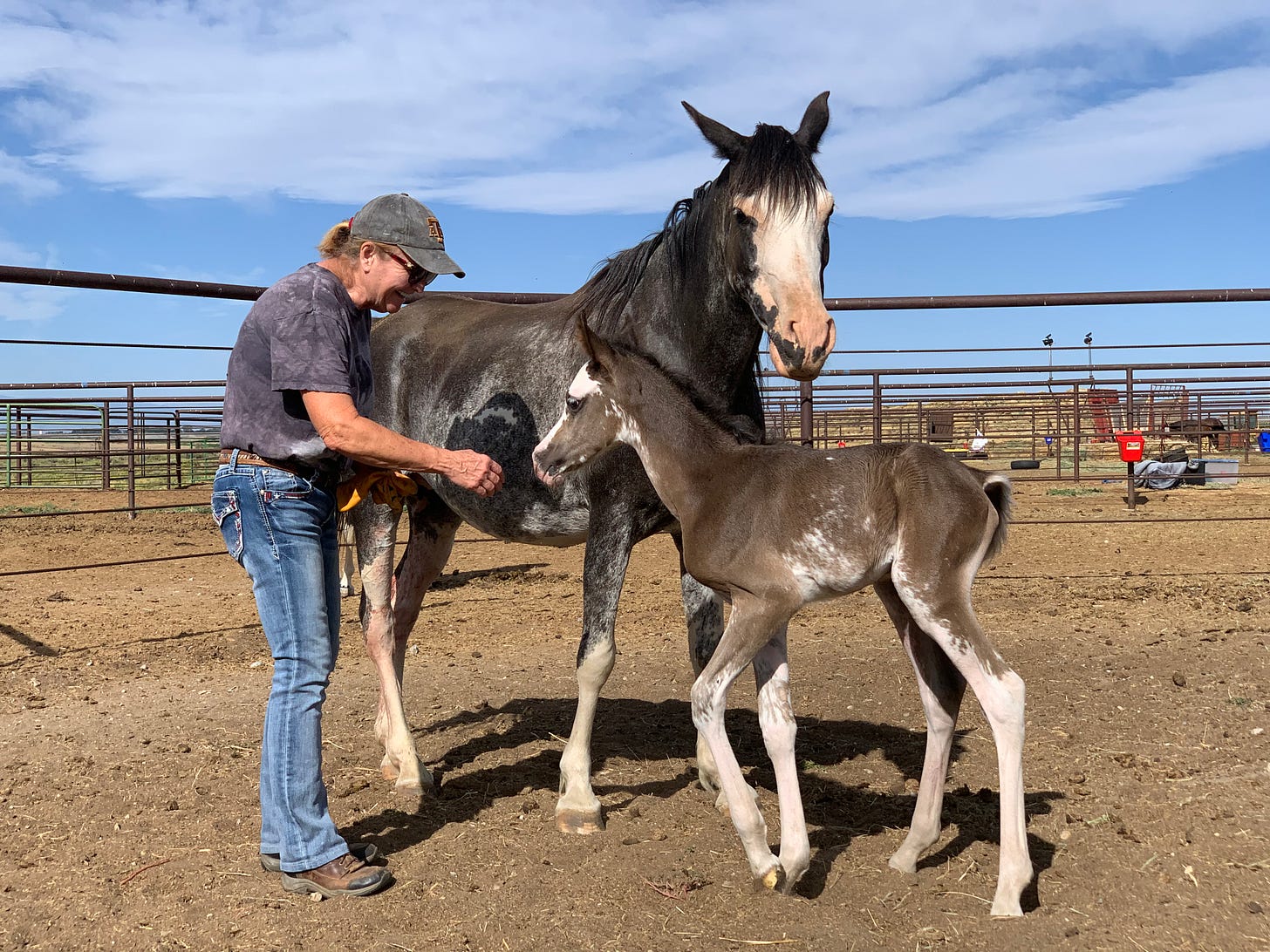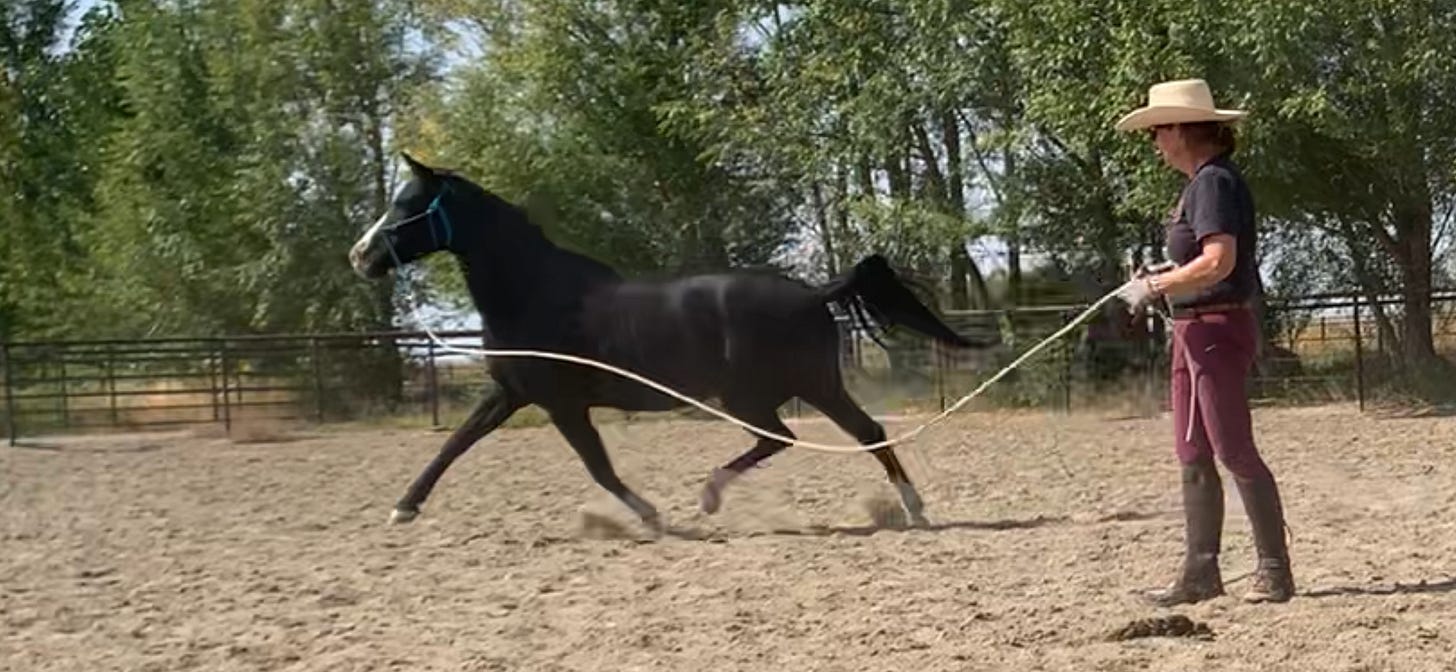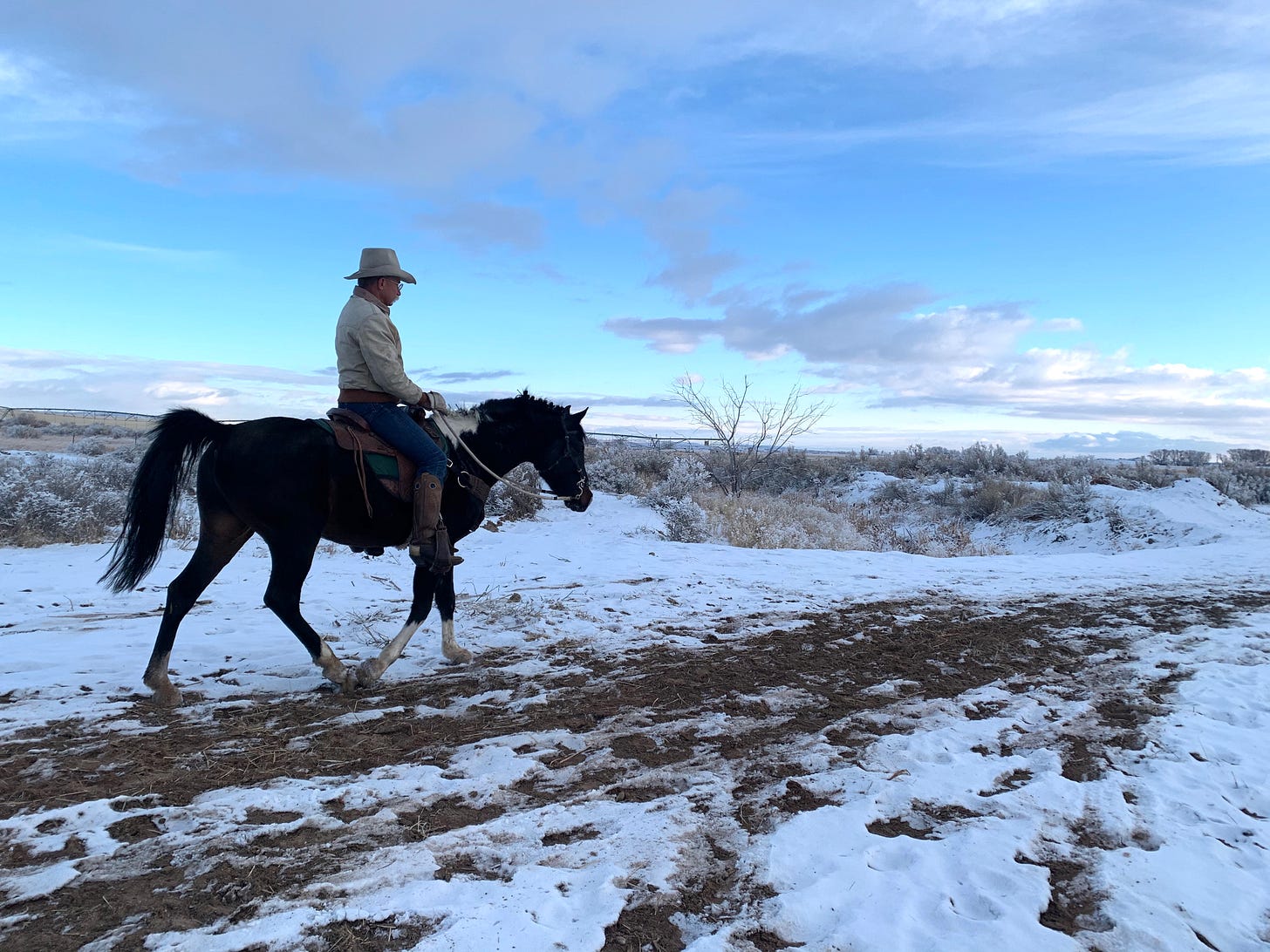If you haven’t read my article on An Overview of Horse Personalities, click here to read it first. This article will make more sense if you do.
The purpose of this article isn’t to teach the nuts and bolts of getting horses to do circles. There are a lot of great horsemen who can teach that really well. My focus here is to talk about strategies and empathy. I’m making the assumption that the horse already knows how to circle, at least on a basic level.
When your horse is thwarting your goals of any task, it’s not because they “hate you” or they’re “being stubborn”, it’s not because they are “crazy” or “mean”. I’ve heard quite a few people refer to their horses as “as….les”. None of that kind of thinking leads to positive outcomes for you and your horse.
As Buck Brannaman has said and many a horseman has pondered:
“The hardest thing a horseman has to do is manage his emotions.”
Right on. The only thing I would add is “…manage his negative emotions.” It’s fear, frustration, and fury that can really get horsemen in trouble. If we can’t control our negative emotions, how can we expect our horse to do it?
Understanding personalities is a fascinating intellectual exercise, but as a horseman, I’m even more interested in how it can help me have a better relationship with my horse. Especially when I’m asking her to do things she wouldn’t normally think about or do on her own.
My goal is to get a horse hooked on learning and to see me as a source of fun and comfort. I want them to want to be with me because I provide them with stimulating challenges, rewards, and positive experiences their four-legged herd members can’t provide.
Circling horses in particular seems like quite the obsession in the human world. You see it in basic training to the highest levels of Dressage (Western and English versions), Working Equitation, and Reining, to name some of the most popular disciplines. But go watch horses in the wild or in your backyard, and even a well-trained horse who can circle beautifully won’t just break out and start spontaneously performing perfect circles out in a pasture. If you’ve seen that, send me the vid!!
When we ask a horse to do a task, I believe we should know why we’re doing it. If we aren’t motivated to do it with a purpose in mind, can we be surprised when our horses aren’t motivated or are confused about a given task?
Here are some reasons we teach circles to horses. You may think of more.
Safety. A horse you can bend (and bend into a circle) is a horse you can better control. This is pretty critical when first teaching horses to carry riders, that is if your goal is to keep riders in the saddle. As a starter of horses, that’s at the top of my list.
Steering. Circling helps the horse understand how we can communicate with the front and hind legs.
Strengthening. Circling for a horse, especially at a trot and canter, is like doing a one-arm pushup with the inside hind leg (trot) or the outside hind leg (canter).
Lead changing on command. Circling aids the horse in understanding leads and that a lead change is desired, along with what cues to look for. Eventually, you want to do them on straight lines as well. Lead changing is helpful for long-distance events, like endurance riding, where you don’t want one hind leg getting completely crapped out and unable to perform, limiting a horse’s ability to travel greater and greater distances in one session. The level of control and versatility demonstrated with lead changing is an important component of most high-level disciplines, as it requires exquisite training, superb communication, and athleticism in both horse and rider. It is a test of the level of partnership the horse and rider have attained.
So, yes, circles are important to us humans. But the horse? Not so much. When we approach tasks a horse would virtually never do by themselves, it’s important to think about it from the horse’s point of view, if you’d like to succeed at it with some level of competence.
Empathy is an important component of Relationship Based Horsemanship.
As promised in my last article on horse personalities, I’m going to review the idea of training horses to circle through the lens of personality traits and behaviors. I train horses initially from the ground, so this is the perspective I will use in this article.
Remember that a rope, at whatever length, acts like a moving round corral. It’s easy to force horses to do things inside a round corral, even a moving one. Ask yourself when you are using a rope, am I being heavy-handed and forceful, or am I asking subtly, looking to develop a partnership and rewarding effort along the way?
A horse’s lack of enthusiasm or outright fear of a task typically comes from either:
Psychological worries/resistance
Physical discomfort or lack of strength/flexibility
If you feel you are doing a good job of understanding your horse psychologically, then make sure to check out any physical barriers to success.
Horses have universal signs of tension/relaxation. Look for them so you know your horse is in a learning frame of mind. Like humans, horses learn very little when they are tense or frightened.
Examples of relaxation:
Deep blinking
Licking and chewing
Relaxed/extended lower lip
A quiet tail
A soft eye
Floppy ears
Examples of tension:
Staring
Tight, immobile lips
A pulled-up lower lip
Swishy, active tail
Wide, unblinking eyes
Flattened ears
With this brief review of some basic Relationship Based Horsemanship information, let’s delve into the psychology of the circle.

The Vigilant Horse:
Review: This horse is motivated by comfort and consistency. Sometimes they like to move, while others prefer to stand still. It’s important to discern between the two. He doesn’t mind repeating tasks because he’s also motivated to get things right. Pushing him when he’s lost confidence or frightened can lead to the creation of a four-legged tornado. They aren’t “crazy”, but our predatory behaviors and unfamiliar pressures sure can make them look that way.
He might react with, “Why you are sending me away?” Or “The pressure from that human feels unsafe.” Or just, “This scares the poop out of me.” These can lead to confusion and/or diminished confidence. This is why shorter ropes can be better at first for these horses, giving them more of a sense of security and clearer communication. You will often see them looking to the outside of the circle in search of an escape route from pressure or to seek a more comfortable situation. They can pull/lean on the rope in an attempt to get away. They can also attempt to bolt away, ripping the rope right out of your hands if you aren’t paying attention.
Anecdote: First, slow down everything you’re doing. When this horse gets worried on the circle, bring him back in and pet him. Breathe slowly and don’t send him back out to try again until he’s in a learning frame of mind. Be PATIENT. Be inviting, remembering that trust is a big issue for these horses. Be the source of calm and consistency for him. He will feed off of your energy by using it to get even more upset if you’re pushy and demanding, so make sure to send him back out calmly. Bring him back in after just a 1/4 circle and lather rinse repeat until he’s no longer worried about being sent away from you.
As he becomes more and more confident about being sent away, and when you can see him get more relaxed out on the circle, you can ask him to finish a circle, then do multiples. Bring him back in and tell him he’s getting it right. You may have to repeat this over many sessions, but once this horse trusts you, he will work his heart out for you.
The Energetic Horse:
Review: This horse is motivated through movement and play. Remember that she needs to/loves to move her feet. Blocking her from moving can either frighten or frustrate her, and I prefer my thousand-pound friends to be relaxed and happy. If she becomes defiant or flighty it’s likely because you’re too rooted to the ground, you’re pressuring her too much, or you’ve lost your sense of humor.
She might respond with, “Why are you limiting me to this circle?” “There’s a big world out there, and I need room to move!” “For goodness’ sake, you’re getting in my way!” This horse might be looking to escape or get fractious because she sees the circle as boring or too small. When she pulls away, she’s looking for something more interesting and/or less restrictive.
Anecdote: Be sure you are matching this horse’s energy. If you act like Eeyore, she’ll likely ignore you. Using a longer rope is often a very good idea, anything longer than a 30 ft. rope works pretty well. The longer length gives her the freedom to move forward more easily. Smaller circles are good when she becomes more compliant. Also, don’t ask her to do a lot of circles, because when they get confident, which they tend to do pretty quickly, they don’t appreciate repetition. Naughty behavior often follows.
Do everything with an upbeat attitude, because if you get mad, they’ll just get naughty or more worried. Weave tasks together or be creative with the circle to keep her interested. Look for her feet to get “sticky”. This usually means she’s come off her adrenalin and is starting to think, or she understands what you’re asking for. When that happens, it’s definitely time to move on to the next (t)ask.
The Curious Horse:
Review: This horse is motivated by new challenges and new environments. He loves puzzles and is the “Houdini” horse who manages to unlock doors and gates that aren’t well secured. He doesn’t really care if he pleases you or not. If you try to bully him, he’ll dig his heels in and flat-out refuse or move like he’s stuck in molasses. If he’s “lazy” or defiant, you’ve failed to make it interesting for him! He loves food and will be motivated by it, but don’t allow him to be pushy or demanding about food, or the next thing he eats might be you.
He might think, “How boring is this? “What’s the point?” You might ask him out on the circle and he just looks at you like, “You and what army are going to make me do that?” They will stare you down, like a gunfighter at the OK corral. If you do manage to get him going, they often get slower and less responsive with every step.
Anecdote: When motivating him, it helps to be a bit naughty yourself. It’s often helpful to surprise him. An example of this is slapping the ground with the string on your stick right next to his feet with no warning as you ask him out on the circle. He might take offense, but a truly curious horse won’t be worried by it. They’ll often start looking at you like you might be worthy of respect. If you do this, it MUST be with a playful attitude; I like laughing out loud when I do it. Think of it as a game of tag. The point of that game is: don’t get tagged. Curious horses figure that game out pretty fast, especially if they allow you to tag them once. When you ask him onto a circle, he’ll start thinking, “I’ll be darned if that human tags me again!”
Ask him to do gait transitions on the circle sooner and more often. Teach him to back up on a circle. Also, once you’ve got a positive relationship established and some skills developed between you, take him out of the arena/corral, please! Often a change of scenery can really help bring out the life and willingness in these horses.
The Reserved Horse:
Review: This horse is motivated by comfort and/or food and puzzles. She doesn’t particularly like moving her feet until she’s interested or calm. She is far less likely to show signs of distress outwardly unless you’re really looking for them, so be watching for those signs, some of which I’ve listed above. Moving fast around her will make her annoyed or worried about you, especially at first. She can be motivated by food, but if she refuses a treat, this is a good way to know she’s worried. Pushing/bullying her can lead to defiance or terror.
She might ponder, “What’s in it for me?” “That takes too much effort!” “I don’t understand why I have to do this.” Or she might react with, “Yikes, that’s a lot of pressure!” She can get immobilized by fear or boredom. With a reserved horse, it’s important to discern between the two. Being passive while this horse is trying to do what you ask is very important.
If you match this horse’s lower energy you will immediately make her feel more comfortable. If she’s bored, you have to be more interesting and pointed with your instruction. If she’s afraid, you have to slow down even more and teach her in small bite-sized pieces until she trusts you to be a source of comfort for her.
For either, waiting for them to respond is important. If you push her while she’s thinking a task through or is afraid, you’ll either annoy her or increase her worry and lack of confidence.
When you ask her to go out on the circle, use smaller cues and wait for a response. If she doesn’t respond, continue to up your energy and cues until you get the response you want. If she is more confident, add pressure quickly and up close (surprise!), or add pressure slowly and from a distance if she is less confident. Some reserved horses need more variety, while others prefer more consistency. If she is more reactive, she needs consistency. Repeating tasks until she is relaxed breeds confidence. If she is less reactive, she needs variety. A variety gives the less reactive horse a sense of purpose critical to her motivation.
These are all guidelines, not rules, tendencies, or absolutes. Use them as ways to experiment so you can get to know yourself and your horse better. If something isn’t working, ask yourself, “What could I be doing differently?” If your horse becomes less confident, change your strategies appropriately. As your horse grows more confident, grow with her and adjust your strategies accordingly.
Here are some interesting revelations that might come along as you experiment with these guidelines:
I can’t seem to bring my energy down enough to get my horse relaxed around me…
I can’t seem to bring my energy up enough to get my horse’s attention or respect…
I need to learn to adjust my strategies more quickly when my horse becomes more/less confident…
There are some things my horse is more confident about than I am…and vice versa…
I feel as though I’m too insistent with my horse
I feel as though I’m not insistent enough with my horse
and many, many more.
Please have fun with all of this and be kind to yourself and your horse when building skills and especially when confidence is an issue.
For all horse personalities, don’t ask a trying horse to try. I’ll talk about that subject in an upcoming article.
For more information about the amazing horses that have been and are being bred on the HAAP farm, go to www.arabpinto.com
If you have questions for me about any of my posts, please feel free to contact me at isabellefarmer@gmail.com or visit our Facebook page at www.facebook.com/arabpintos









This is great! I’ve just started my next article themed around creating volition or building on my horse’s natural tendencies towards curiosity! Slowing things down enough to stay present, for both of us is a huge tool as well as finding “safe” ways to bring out his curious side. I find when he’s not engaged or feeling safe, he turns more towards his suspicious side- the shadow of his curiosity. That’s when he gets reactive and negatively emotional, we we need to come back to safe things until presence is re-established. Thanks for linking me this!